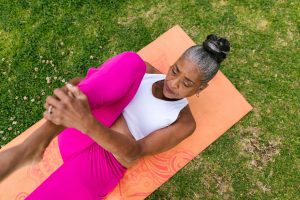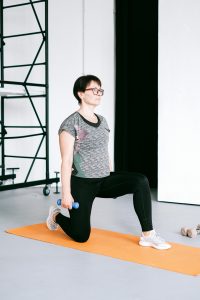What Happens to the Female Body Before Menopause, and Why Trainers Need to Understand It
We all know the term menopause and many even know how to work with women experiencing it, but how familiar are you with menopause’s predecessor? Perimenopause is the phase that marks the end of menstruation and childbearing years, and the beginning of menopausal symptoms. It is a transitional period and can be an awkward in-between stage for women and their trainers if they don’t understand or lean into it.
Recognizing the Phase
Perimenopause can impact training outcomes, even in healthy, active clients. The shifting hormones and associated body changes can affect energy levels, recovery time, consistency, and motivation in workouts. One of the most important things we can do is to help women recognize this phase (if they’re not already aware), and normalize this period in their lives.

Perimenopause can come on quickly, but it often starts so slowly and subtly that many women are not initially conscious of these changes. Recognizing premenopausal symptomscan help you guide your female clients toward programming that will ease the transition to menopause. These symptoms include:
- Irregular menstrual cycles (assuming the female athlete triad or other imbalances are not present)
- Hot flashes and/or night sweats
- Mood swings or irritability
- Sudden weight gain, especially in the midsection.
Should your clients talk to you about these or other related symptoms, it might not be the best idea to blurt out “I think you’re entering menopause!” Trust me, it probably won’t go over well. As you discuss the possibility, do so with empathy and encouragement. Just like the transition from child to teenager or from teen to young adult, the shift may seem uncomfortable to some. It can seem like the end of youth for some women, but it doesn’t have to be. The way you motivate and encourage movement can help these women feel strong and capable, not like they’re one step away from grey-haired incapacitation.
Stepping Up to Lead
The perimenopause stage is an important opportunity for trainers to step up and step in with customized support and increased encouragement. Once you understand your clients’ symptoms, you can work with your client to set goals that not only benefit them during this phase, but will prepare their body for the menopause and postmenopause to come.
By adjusting your programming for perimenopausal clients early, you can help them preserve muscle mass, support bone density, and improve their metabolic response. All of these tend to decline when a woman enters menopause, but their effect can be greatly reduced through regular physical activity in the years leading up to it. We, as trainers, are on the frontlines of delivering support to these women.
What Types of Exercise Best Support Clients During Perimenopause?
Your client’s symptoms during this time may dictate much of your exercise programming. The best type of exercise for clients in perimenopause is the kind that helps build confidence with a side of strength – activities like resistance training, enjoyable aerobic activity, and functional core work.
Build a balanced routine for your perimenopausal clients that incorporates four key areas:
- Strength training done 2-3 times per week on nonconsecutive days helps maintain muscle mass, supports a healthy weight, and protects bone health. If your client is new to strength training, start with bodyweight exercises and move to weights when they’re ready.
Something I learned as a new trainer years ago was to set my clients up for success by setting them up for home exercise. For clients experiencing life or health changing events, like perimenopause, menopause, or chronic disease, clients may not always make it into the gym. Symptoms may win out some days, but we, as trainers, can still support them on those days. On your in-gym days, highlight which exercises from their program can be done at home. Not every client will take the initiative to exercise on their own, but some will. Those are the clients whose lives you’ll see change.
- Moderate aerobic activity for at least 150 minutes per week works to boost energy and heart health. If your client is just starting to be physically active, 150 minutes may seem like a lot. Encourage variety in their routine, helping them see that aerobic activity is more than walking. It is dancing, cycling, hiking, and tennis.
One way to get your clients moving more is to shift their focus. Rather than committing to 150 minutes of aerobic activity, invite them to commit to meeting friends for tennis twice a week, taking a walk around the neighborhood each night, or signing up for a group dance or exercise class. Promising to do a fun activity is much more enjoyable than promising to get tired and sweaty.

- Flexibility work performed on its own or in combination with other exercise can be done every day (or at least most days) to reduce stiffness and improve range of motion. If your client isn’t already doing regular stretching, now is the time for her to start. Stretching can help alleviate the muscle aches and joint pain that come with perimenopause.
A big bonus here is to give your clients a simple nighttime stretching routine, one they can do before going to bed. Many women in perimenopause have difficulty sleeping or have increased anxiety symptoms. Gentle stretching can ease distress and help the body and mind relax for better quality sleep.
- Core and breathwork 2-3 days per week improves posture, improves cognitive function, and balances moods. These two types of exercises are so overlooked in all populations, but especially in women as they age. As both a personal trainer and a yoga teacher, I can vouch for the good they do!
Breathwork is not breathing into a brown paper bag like we see on TV. It is simply an invitation to be aware of one’s breath. In some breathing techniques, this awareness is passive. In others, the individual takes a more active role in controlling their breath. The next time you have down time between clients, try out some breathing practices you can share with your clients, like box breathing or 4-7-8 breathing. Be sure to understand the contraindications that come with breathing exercises for certain populations, such as avoiding breath retention in clients with hypertension.
Core work for perimenopausal clients is less about the 6-pack and more about having an actually functional core that supports their body. Program exercises that move the core muscles in various directions and that mimic movements in everyday life, such as bending, twisting, pushing, and pulling.

An often missed part of core work is exercising the pelvic floor. Yes, I heard your collective groan. Nobody loves to talk about the pelvic floor, but it’s one of things we should all be talking about. It’s not going to go away just because we shove it under the rug. Many of the issues that occur during perimenopause and menopause can be resolved or mediated by pelvic floor exercises. If you don’t want to spend your session coaching these exercises, at very least, provide some good instruction and a home exercise plan to help your clients strengthen this vital area.
Symptom-centric Training
A comprehensive exercise program includes all these elements tailored to the specific goals and symptoms your client is experiencing. Don’t be afraid to niche down during your client’s perimenopausal phase. Lean into what they need and what is working for them right now.
For clients experiencing poor sleep or stress, emphasize yoga, tai chi, or breathwork.
If a client is losing muscle, focus on resistance training.
For clients wanting to combine muscle gain with weight loss, try interval training. High intensity interval training may be appropriate for those with at least a moderate level of fitness who want a boost in strength and metabolism. HIIT is also high-impact, making it a good bone strengthening activity for those who are not at risk for osteoporosis or other bone injuries.
If a client has joint pain, encourage mobility training and low-impact exercise like swimming or elliptical training.
Combine your knowledge with your client’s experience to develop a program that is personal and practical. Focus your programming on meeting initial needs and remedying her symptoms that are the most bothersome or the easiest to relieve.

Does Exercise Help with Other Perimenopausal Symptoms?
Yes! Aside from the obvious connections between exercise and relief of joint pain, weight gain, and mood improvement, exercise can greatly impact other less-addressed perimenopausal symptoms.
A common symptom of perimenopause is cognitive change. Brain fog and difficulties with concentration and memory are complaints many women have at this stage of life. Exercise increases concentration as clients focus on form and reps. Aside from muscle gains, memory gains also add up with regular exercise.
Incorporate cognitive challenges to your regular exercise routine. These are one of my favorite ways to add intensity to an exercise without adding physical intensity. I have clients draw alphabet letters in the air with a medicine ball during core work or invite clients to remember what exercise comes next in our session. Little things that jog the memory or require increased concentration can build a strong cognitive foundation for your female clients.

Why Now Is the Time to Empower Your Perimenopausal Clients Through Movement
Perimenopause is a pivotal window where we, as trainers, can make a lasting impact. We can help clients maintain muscle mass, bone density, and mental clarity through thoughtful, hormone-aware programming. It doesn’t take a certification in women’s health to know how to help women. It does take education and maybe some uncomfortable conversations about symptoms, but those efforts will lead to more comfortable exercise and living for your female clients as they make this new life transition. While each woman’s experience is unique, movement guided by empathy and expertise is one of the most powerful tools a trainer can offer to support long-term health and quality of life.
Ready to Support Others Through Movement?
If you’re a fitness professional, understanding the unique needs of women in perimenopause is a game-changer. Insure Fitness Group supports you with affordable liability coverage, so you can confidently guide women through every phase of life. Get an estimate today and grow your impact with confidence!





